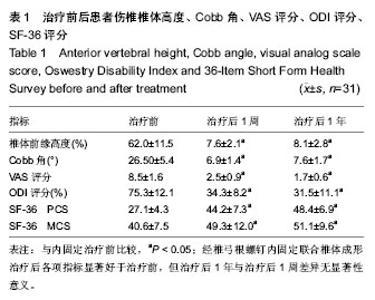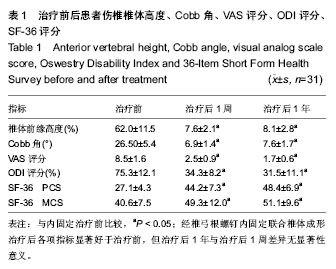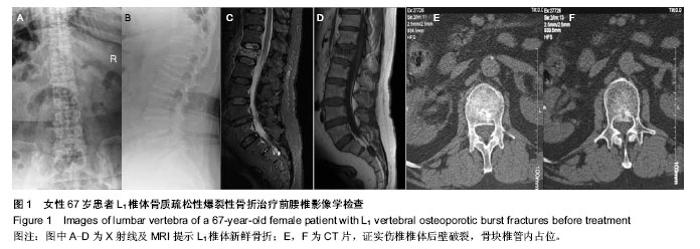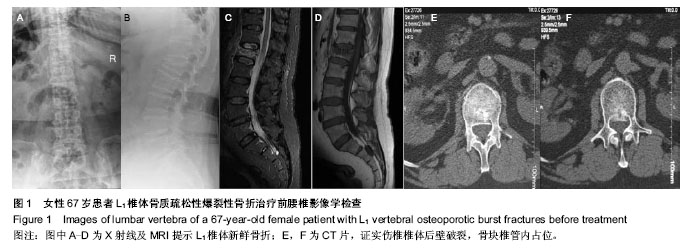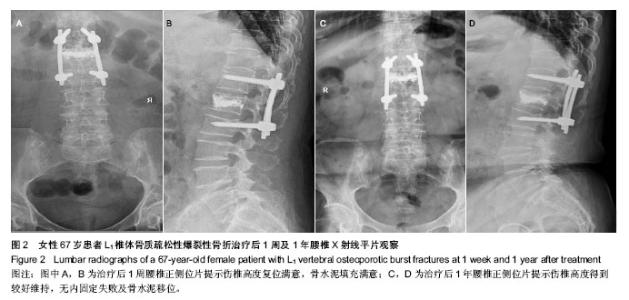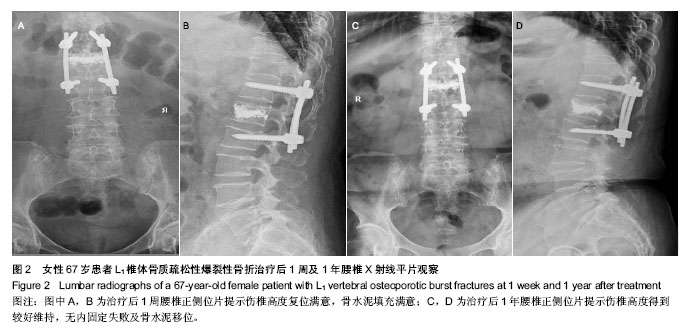| [1] Lee YK, Jang S, Lee HJ, et al. Mortality after vertebral fracture in Korea: analysis of the National Claim Registry. Osteoporos Int.2012;23(7):1859-1865.
[2] Sakuma M, Endo N, Oinuma T, et al. Incidence of oste oporotic fractures in Sado, Japan in 2010. J Bone Miner Metab.2014;32(2):200-205.
[3] Kim KW, Cho KJ, Kim SW, et al. A nation-wide, outpatient-based survey on the pain, disability, and satisfaction of patients with osteoporotic vertebral compression fractures. Asian Spine J.2013;7(4):301-307.
[4] Chen D, An ZQ, Song S, et al. Percutaneous vertebroplasty compared with conservative treatment in patients with chronic painful osteoporotic spinal fractures. J Clin Neurosci.2014; 21(3):473-477.
[5] Venmans A, Klazen CA, Lohle PN, et al. Natural history of pain in patients with conservatively treated osteoporotic vertebral compression fractures: results from VERTOS II. AJNR Am J Neuroradiol.2012;33(3):519-521.
[6] Anderson PA, Froyshteter AB, Tontz WL Jr,et al. Meta-analysis of vertebral augmentation compared with conservative treatment for osteoporotic spinal fractures. J Bone Miner Res.2013;28(2):372-382.
[7] Wang E, Yi H, Wang M, Huang C. Treatment of osteoporotic vertebral compression fractures with percutaneous kyphoplasty: a report of 196 cases. Eur J Orthop Surg Traumatol.2013;23 Suppl 1:S71-75.
[8] Kong LD,Wang P,Wang LF,et al. Comparison of vertebroplasty and kyphoplasty in the treatment of osteoporotic vertebral compression fractures with intravertebral clefts.Eur J Orthop Surg Traumatol.2013;doi:10.1007/s00590-013-1374.
[9] Hartmann F, Gercek E, Leiner L, et al.Kyphoplasty as an alternative treatment of traumatic thoracolumbar burst fractures Magerl type A3.Injury.2012;43(4):409-415.
[10] Wu J, Xu YQ, Chen HF, et al,et al. Percutaneous kyphoplasty combined with the posterior screw-rod system in treatment of osteoporotic thoracolumbar fractures. Indian J Orthop. 2013; 47(3):230-233.
[11] Patil S, Rawall S, Singh D, et al. Surgical patterns in osteoporotic vertebral compression fractures. Eur SpineJ. 2013;22(4):883-891.
[12] 张文捷,张亮,赵春明,等.经椎旁肌间隙入路治疗胸腰椎骨折[J].脊柱外科杂志,2011;9(2):98-101.
[13] 张林林,杨惠林,姜为民,等.短节段固定联合椎体成形术治疗胸腰段爆裂性骨折[J].中国脊柱脊髓杂志,2011,21(2):161-163.
[14] 徐建成,白靖平,锡林宝勒日,等.注入骨水泥椎体成形与非手术治疗骨质疏松性椎体压缩骨折的Meta分析[J].中国组织工程研究与临床康复,2011,15(13):2366-2370.
[15] Hsieh MK, Chen LH, Chen WJ. Current concepts of percutaneous balloon kyphoplasty for the treatment of osteoporotic vertebral compression fractures: evidence-based review. Biomed J.2013;36(4):154-161.
[16] 顾晓晖,杨惠林,唐天驷,等.后凸成形术治疗椎体后壁破裂的骨质疏松性脊柱骨折[J].中国脊柱脊髓杂志,2004,14(11):649-652.
[17] Tang H,Zhao JD,Li Y,et al.Efficacy of percutaneous kyphoplasty in treating osteoporotic multithoracolumbar vertebral compression fractures. Orthopedics.2010;33(12):885.
[18] Gan M, Yang H, Zhou F,et al. Kyphoplasty for the treatment of painful osteoporotic thoracolumbar burst fractures. Orthopedics. 2010;33(2):88-92.
[19] 王华东,侯树勋,史亚民,等. 椎弓根固定结合椎体成形术治疗胸腰椎爆裂骨折[J].中华创伤骨科杂志,2005;7(6):533-536.
[20] Yang H,Pan J,Sun Z, et al.Percutaneous augmented instrumentation of unstable thoracolumbar burst fractures: our experience in preventing cement leakage. Eur Spine J.2012; 21(7):1410-1412.
[21] McLain RF, Burkus JK, Benson DR.Segmental instrumentation for thoracic and thoracolumbar fractures: prospective analysis of construct survival and five-year follow-up. Spine J.2011;1(5):310-323.
[22] Daniaux H.Transpedicular repositioning and spongioplasty in fractures of the vertebral bodies of the lower thoracic and lumbar spine. Unfallchirurg.1986;89 (5):197-213.
[23] Knop C,Fabian HF,Bastian L, et al.Late results of thoracolumbar fractures after posterior instrumentation and transpedicular bone grafting. Spine (Phila Pa 1976).2001; 26(1):88-99.
[24] Leferink VJ,Zimmerman KW,Veldhuis EF,et al.Thoracolumbar spinal fractures:radiological results of transpedicular fixation combined with transpedicular cancellous bone graft and posterior fusion in 183 patients. Eur Spine J.2001;10(6): 517-523.
[25] Verlaan JJ, van Helden WH, Oner FC, et al. Balloon vertebroplasty with calcium phosphate cement augmentation for direct restoration of traumatic thoracolumbar vertebral fractures. Spine (Phila Pa 1976). 2002;27(5):543-548.
[26] Korovessis P,Repantis T,Petsinis G,et al .Direct reduction of thoracolumbar burst fractures by means of balloon kyphoplasty with calcium phosphate and stabilization with pedicle-screw instrumentation and fusion. Spine (Phila Pa 1976).2008;33(4):E100-108.
[27] Blondel B, Fuentes S, Metellus P, et al.Severe thoracolumbar osteoporotic burst fractures: treatment combining open kyphoplasty and short-segment fixation. Orthop Traumatol Surg Res.2009;95(5):359-364.
[28] 黄卫国,易军飞,白瑞飞,等. 椎体成形穿刺注射骨水泥防止灾难性并发症:87例137个椎体资料分析[J].中国组织工程研究与临床康复,2011,15(30):5669-5674.
[29] 邬江,徐永清,陈汉芬,等. 钉棒复位系统结合椎体后凸成形术治疗椎体后壁[J].中华创伤骨科杂志,2012,14(6):547-548.
[30] 汪字,刘先银,郭建恩,等. 椎体后凸成形与后伸体位恢复骨质疏松性压缩骨折椎体高度12例[J].中国组织工程研究与临床康复, 2009,13(26):5167-5170.
[31] 干曼峰,杨惠林,丁懿,等. 椎体后凸成形术治疗骨质疏松性椎体爆裂骨折[J].中国骨与关节外科,2012,5(1):11-15. |
